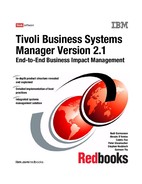
12 Tivoli Business Systems Manager Version 2.1: End-to-End Business Impact Management
Figure 1-3 TBSM console: propagation path
Propagation is the technical component that enables IBM Tivoli Business
Systems Manager to progress from a physical to a logical model. As events are
propagated to the physical parents of an object, they also are propagated to all
Business System Views containing those objects.
1.3.4 Views
IBM Tivoli Business Systems Manager enables you to manage resources in a
way that best reflects your current organization. Your IBM Tivoli Business
Systems Manager implementation can reflect a decentralized or a centralized
control structure. The resources either can be defined to IBM Tivoli Business
Systems Manager or can be discovered using various methods (for example,
components, modules, or programs) to detect the configuration of the resources.
Once the resources are defined or discovered, they are registered in the IBM
Chapter 1. Introduction to business systems management 13
Tivoli Business Systems Manager database; that is, information about the
resources is stored in the database and is available for monitoring and viewing.
The IBM Tivoli Business Systems Manager console and the IBM Tivoli Business
Systems Manager Web console display your enterprise’s resources in various
views. When notifications that trigger alerts are received from the various
collection agents within the enterprise, the alerts are displayed as graphic
overlays on the resources, indicating the different status of your resources.
A resource view displays all the resources registered in the IBM Tivoli Business
Systems Manager database. Business System Views can be created from the
console or automatically from incoming discovery and event data. A BSV is a
logical view that includes any subset of the registered resources that are of
interest for monitoring. Each resource is represented as an icon within the view.
You can create, save, and later access BSVs. Opening several windows, each
containing a different BSV, enables you to monitor different resources and their
various relationships from a single workstation. BSVs can be based on an actual
business system or on:
? An application or set of applications
? A department
? A vertical area of responsibility
? A geographic region
Some examples of Business System Views are:
? Real estate (business system)
? Inventory, software distribution (applications)
? Human Resources (department)
? Email gateway (vertical area of responsibility)
? Asia Pacific South Operations (geographical region)

14 Tivoli Business Systems Manager Version 2.1: End-to-End Business Impact Management
BSVs enable you to organize logically the resources that you want to monitor and
display them in the resource system views and Business System Views using
these methods:
? Tree view, which shows the hierarchy of the resources. Branches in the tree
can be expanded or collapsed to show or hide resources. We can see this in
Example 1-4.
Figure 1-4 TBSM console: tree view
..................Content has been hidden....................
You can't read the all page of ebook, please click here login for view all page.


